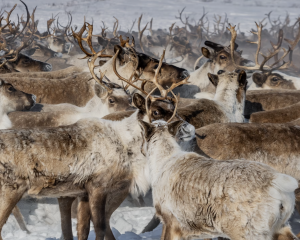Thousands of reindeer plod across the frozen far reaches of northwestern Canada.
數千只馴鹿艱難跋涉,穿越加拿大西北部冰封的偏遠之地。
In the slow-moving scrum, the animals' bodies almost disappear under a cloud of vapor as warm breath collides with cold air.
鹿群比肩接踵緩慢行進,隨著溫暖的吐息與寒冷的空氣碰撞,它們的身軀幾乎隱沒在陣陣霧氣之下。
A forest of antlers seems to dance in the mist.
鹿角筑成的森林似乎在霧中起舞。
Glimpsed from afar, the migrating herd looks like one long, sinuous streak of brown painted across the snow-white canvas of an Arctic landscape.
遠遠望去,遷徙中的鹿群如同一道綿長且蜿蜒的棕色條紋,涂抹在如畫布般的北極雪白大地上。
In the distance are four Inuvialuit herders on snowmobiles, armed with rifles and keeping watch.
遠處有四名伊努維亞盧特牧民,他們駕駛雪地摩托車、攜帶步槍并時刻監督著。
They are alert, attuned to the rhythm of hooves falling on frozen earth, and on this crisp morning their job is to escort the reindeer to their calving grounds -- but in a grander sense, they are also helping to write a new legacy for this storied herd.
他們十分警覺,能夠敏感辨別出鹿蹄落在冰封大地上的節奏,而在這個寒冷的早晨,他們的工作是將馴鹿護送到產犢地--但從更宏觀的意義上來說,他們也正在幫助這個擁有精彩歷史的馴鹿群書寫新的傳承。
"They're really smart animals," said Douglas Esagok, whose seven winters working with the reindeer make him among the most experienced of the Indigenous herders.
道格拉斯·埃薩高克說:“它們是非常聰明的動物。”他已經與馴鹿相處七個冬季,這使他成為經驗最豐富的原住民牧民之一。
"I'm always talking to them when I'm moving them. It kind of calms them down, when they recognize my voice or the sound of my snow machine."
“我驅使它們前進的時候,總會跟它們講話。它們認得出我的嗓音或我的雪地摩托車發出的聲音,這多多少少有助于它們平靜下來。”

As Canada's last free-ranging reindeer herd drives forward, just north of the Arctic Circle, the animals carry with them a link to a legendary experiment.
加拿大最后一群自由放養的馴鹿正在北極圈內前進,它們與一項傳奇實驗息息相關。
It began about a hundred years ago, after the number of local caribou that the Inuvialuit long depended on began to decline and a bold plan was hatched to address food scarcity by importing reindeer. (Caribou and reindeer are the same species, but the latter have been domesticated.)
這項實驗始于大約100年前,當時伊努維亞盧特人長久以來賴以維生的當地北美馴鹿數量開始減少,為了解決糧食短缺的問題,政府制定一項大膽的計劃:引進馴鹿。(北美馴鹿和馴鹿是同一物種,但后者已經馴化。)
Something similar had been tried at the turn of the century in nearby Alaska, when waves of reindeer boarded boats and trains to make improbable journeys from Siberia and Norway to North America.
鄰近的阿拉斯加曾在19、20世紀之交嘗試過類似舉措,那時一批又一批馴鹿登上船只及火車,從西伯利亞和挪威運送到北美洲,踏上不可思的旅程。
In late 1929, a chunk of what was then a burgeoning Alaska reindeer population -- some 3,500 reindeer -- set off for Canada under the care of Sami and Inuit herders.
1929年底,在薩米及因紐特牧民的照料下,大約3500只馴鹿前往加拿大,他們屬于一個當時數量迅速增長的阿拉斯加馴鹿族群。
The arduous, zigzagging 1,500-mile journey ended up lasting more than five years, marking a difficult beginning to what came to be known as the Canadian Reindeer Project.
這趟艱巨且迂回的旅程長達2400公里,最后持續五年多才告終,這項后來稱為“加拿大馴鹿計劃”的行動就在此艱難的開端下展開。
Now, decades on, a group of Inuvialuit stakeholders is taking the project further into uncharted territory.
而數十年后的今天,一群伊努維亞盧特人正在將這項攸關他們福祉的計劃進一步推動到未知的疆域。
The herd, which has been cared for with the help of the Inuvialuit but family owned, was formally purchased in 2021 by the Inuvialuit Regional Corporation.
這群馴鹿原本是由某個家族擁有,但一直在伊努維亞盧特人的幫助下進行照料,2021年由伊努維亞盧特地區公司正式收購。
Under the watchful eyes of Esagok and his colleagues, the herd has more than doubled, to nearly 6,000 reindeer, making possible an ambitious plan to build a sustainable path to self-reliance for Inuvialuit people living on their ancestral lands.
在埃薩高克和同事的密切關注之下,這群馴鹿的數量已經增加了一倍多,達到將近6000只,使一項雄心勃勃的計劃有望實現,這項計劃希望為生活在祖傳土地上的伊努維亞盧特人打造一條自給自足的永續道路。
"The ultimate goal is to have reindeer abundantly available for Inuvialuit -- that's goal number one," said Brian Wade, director of the Inuvialuit Community Economic Development Organization.
“終極目標是為伊努維亞盧特人提供數量充足的馴鹿--那是首要目標。”伊努維亞盧特社區經濟發展組織的主任布萊恩·章德說。
"There's the food security component to this herd, but there's also job creation and the economic component to it."
“這群馴鹿不但能保障糧食生產充足,也能創造就業機會并促進經濟。”



